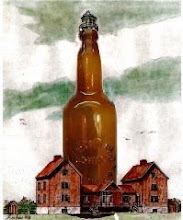by Garret Ellison - Don’t be surprised if you see a large fire-breathing beast perched atop the new outdoor fermenting tanks installed at the New Holland Brewing Company in the future. The new equipment installed at the brewery’s production facility in Holland Township this week are the largest pieces of a $3 million expansion by New Holland this year to meet “exponential” demand growth for specialty brews like their Dragon’s Milk. The five new 400-barrel outdoor tanks, shipped over from Germany, will allow the brewery to more than double brewing capacity, said CEO Brett VanderKamp. “We couldn’t push another drop of beer through the system right now,” said VanderKamp, who started New Holland in 1996 with Jason Spaulding, who left to establish Brewery Vivant in Grand Rapids.
New Holland anticipates brewing about 23,000 barrels this year. The new tanks will allow the company to reach 50,000 barrels per year, said VanderKamp. The company is experiencing 40 to 50 percent in top line revenue growth, said VanderKamp, although he declined to release sales figures. New Holland distributed 15,000 barrels of beer in 13 states in 2011. Each barrel holds about 31 gallons.
“We’re seeing across-the-board growth in both the mainstay brands like Mad Hatter, and solid growth in our Dragon’s Milk,” he said. This year, New Holland is doubling production of Dragon’s Milk, a bourbon barrel-aged ale with complex flavors of oak, vanilla bean and chocolate. The “high gravity” beer clocks in at 10 percent alcohol by volume. New Holland’s website describes the painstakingly-crafted brew as a “crown jewel.” The brewery recently built a new aging cellar to hold up to 3,200 Kentucky bourbon barrels, which the Dragon’s Milk matures in for at least 90 days.
Brett VanderKamp, president of New Holland Brewing Company, talks about the construction of five 400-barrel outdoor fermenters that are part of a $3 million expansion project which will more than double the company's brewing capacity. Other changes to the production facility include a rebuilt bright conditioning tank cellar, which will house four tanks by the end of May, said Brewmaster John Haggerty. New Holland also added a new centrifuge to help clarify larger batches of beer more quickly.
The expansion will allow New Holland to not only expand their distribution footprint around the country, but also to expand product availability on shelves within the current distribution area, which VanderKamp said was “critical” for the brewery. The brewery brought on another four brewers amid the production expansion. They anticipate creating another 8 to 10 jobs in the next two years, he said. The brewery started laying the groundwork for the expansion about a year ago. Haggerty began looking around the country at operations using the outdoor system and settled on tanks built by a Germany company called Ziemann.
Haggerty said the tanks are temperature-controlled and built to withstand the heat of summer as well as the cold of winter without any adverse side effects to the beer. Each tank has six inches of foam insulation blown into the space between the exterior cladding and the stainless tank wall. The tanks were constructed with an indoor room at the bottom for the brewer to access without having to bundle up in January.
“I think we are the first brewery in Michigan to use these outdoor tanks,” said VanderKamp. “Most everybody had gone the more traditional route of building a building around the tanks.”
The tanks are costing more upfront, but should pay off in the long-run in reduced heating, building maintenance and other overhead costs, he said.
Thursday, May 3, 2012
Subscribe to:
Post Comments (Atom)



No comments:
Post a Comment